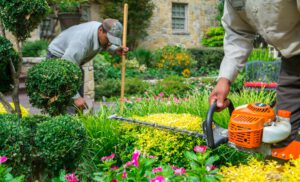Landscaping is a process that modifies the visible features of the land. Landscaping can include irrigation installation, hedging, and fine gardening. Whether you are looking for solutions for a small garden or an entire property, the following article will help you get started.
 Landscape irrigation is a very important aspect of landscaping. It helps maintain a beautiful landscape while reducing evaporation. The layout of the irrigation system will vary based on a number of factors. You can increase your yard’s curb appeal and improve the health of your plants by properly designing the sprinklers and the watering schedule.
Landscape irrigation is a very important aspect of landscaping. It helps maintain a beautiful landscape while reducing evaporation. The layout of the irrigation system will vary based on a number of factors. You can increase your yard’s curb appeal and improve the health of your plants by properly designing the sprinklers and the watering schedule.
Properly designed irrigation systems can save you time and money. They will protect your plants from droughts and help keep your garden looking great. If you still need to install an irrigation system, consider hiring a professional. A professional can install your irrigation system safely and effectively and provide you with the proper information for maintaining it.
Before installing an irrigation system, you should prepare your land for installation. This can include digging holes and laying down mulch. As you prepare the soil, remove any weeds that may grow. Once you have done this, you can begin to plan the layout of your irrigation system.
Hardscaping is a common way to add curb appeal to your property. It is also a useful measure that can enhance the overall functionality of your outdoor space. Using hardscapes is often more cost effective than planting flowers or growing trees.
When designing your landscape, there are a number of factors to consider:
- You need to study your climate and the types of plants that grow there.
- You need to determine what type of design will complement your landscaping.
- You need to consider budgetary considerations.
A well-designed hardscape can help control runoff from watering, deter weeds, and even encourage structured growth. If you’re planning on adding a water feature to your yard, be sure to choose a lining that allows for a smooth flow of water.
Hedging is a great way to enhance your property. It adds beauty, structure, and privacy to your yard. Besides, it is less expensive than fences and walls. But, if you decide to use hedges in your landscape, it is important to know how to choose the right plants. Here are some tips to help you find the right plant for your property.
First, make sure that you choose shrubs that will be able to thrive in your soil type and climate. The next step is to determine the height of your hedge. Then, it is time to consider the eventual spread of your hedge. Consider a double row or a triple row. However, you need to make sure that you do not choose too many shrubs.
If your landscape is starting to show its age, it might be time to bring in the fine gardener. This specialized service can add an extra zing to your property, while providing peace of mind. The fine gardener knows what’s important, and what’s not. They understand your landscaping needs, and can develop a comprehensive plan that will keep your property in tiptop shape.
Fine gardening involves more work on your part than a typical maintenance crew. It’s not a “mow-blow-n-go.” A fine gardener evaluates your individual plants, their place in the landscape, and their overall health. They use various methods to achieve this goal, including integrated pest management, pre-emergent treatments, and custom hand pruning. They also know what the latest plant varieties are and can even recommend solutions to bring out the best in your landscaping.
Landscaping can be a complex task. Homeowners may have specific landscaping ideas in mind, but the landscaper must adapt to the actual plot of land. Landscaping is often a complex process that involves manipulating soil and rearranging trees. Some projects will even involve building structures, such as a pool. In such cases, a landscaper should hire a professional who is knowledgeable in landscaping. So, it’s wise to find a landscaper who is experienced in your area and has the experience to create the ideal environment.
Landscape design is a branch of landscape architecture. Landscape architecture aims to achieve harmony between manmade structures and their natural surroundings. Professional landscapers will usually have a team of experts, including horticulturists and engineers. Typically, the landscaper will lead the project. But the landscaper’s role is to guide the design and construction process, and to create a beautiful and functional landscape. They can do this by using a variety of techniques and materials.
